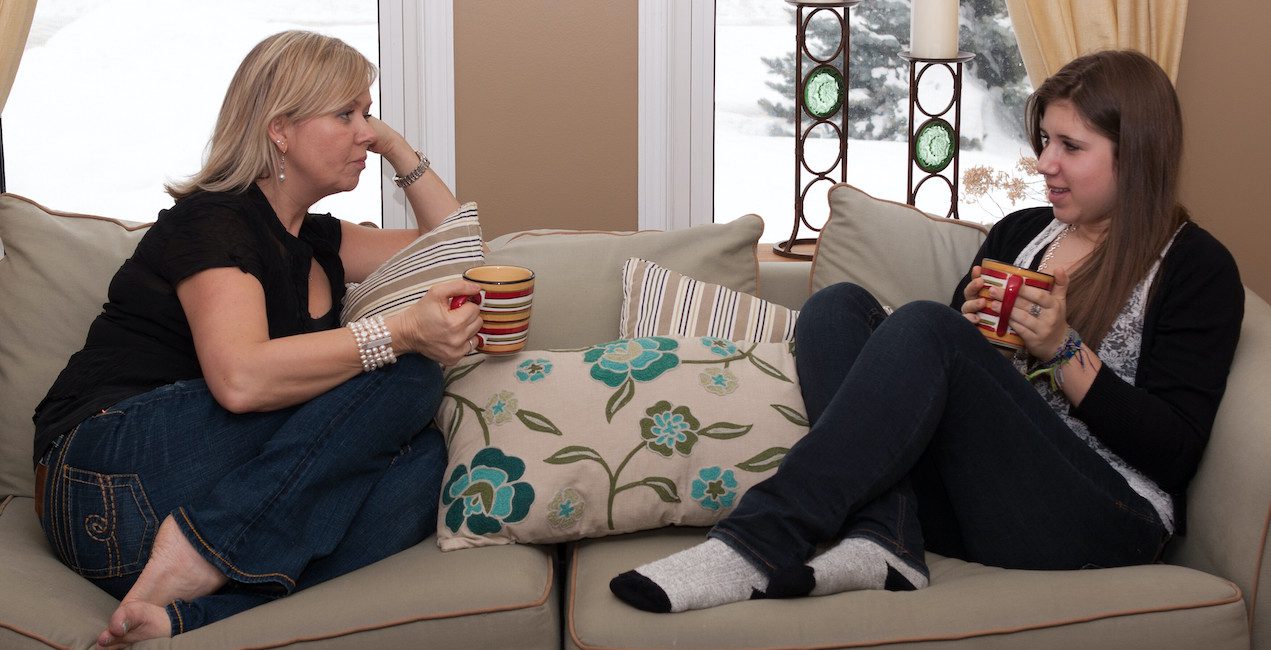The Art of Civil Conversations: 9 Parent Strategies

Posted in: Grade School, Parenting Concerns, Teenagers, You & Your Family
Topics: Child + Adolescent Development, Hot Topics, Relationships
Are you an educator? You may be interested in our Conflict Resolution Curriculum for students. Learn more here.
“Are you out of your mind? You’re not old enough to go to a climate change demonstration. What do you even know about the climate? Besides, we’re in the middle a pandemic. Enough said!”
So says the parent, and turning to leave the room, we see the 13-year-old daughter’s eye-roll.
Does this “conversation” sound similar to one you might have experienced with a parent or guardian when you were growing up? It’s hardly a conversation – more of a harsh proclamation. But instances like this occur far too often.
In the last four years, all of us have experienced significant divisions in our nation and witnessed the most uncivilized arguments, and this has extended to families. Much of the fighting has been due to political divides, and it has been highly emotional, often with stand-alone, one-sided pronouncements like the one above, rather than being based on factual data by people who are clearly and calmly expressing their differences.
Sadly, this uncivilized process has invaded our homes – we all have been under siege. This kind of discourse has found a place in popular media, including very often in the news. Turn on any digital device, and what we hear is a lot of one-sided rants. In addition, due to the pandemic, many families have been living in close quarters with each other while at the same time enduring feelings of extraordinary isolation, laced with worry and uncertainty. For many families, all of this incredible stress has culminated in conversations that are far from civil.
How can we improve this situation, which clearly does not promote healthy growth and well-being for our kids? Like most things that influence development, sound behavior should start at home. Let’s look at what key elements make for healthy, collaborative communication.
First and foremost, think developmentally. We naturally will have different ways of talking with our pre-school, school-age, teenage, and young adult children, as well as with other caregivers at home.
A Guide for Civil Conversation
1. Demonstrate Respect. Whatever the topic or issue is, begin with making it clear that everyone’s ideas and opinions are worthy. This is true for children of all ages. When we talk with each other, demonstrating respect and the value of the other person is vital. Even if we might think that their position is irrational, or that they are too young or inexperienced to understand the subject, give them the honor that they are worthy of expressing themselves. No civil conversation can begin if someone feels disparaged – even a young child.
As caregivers, a key part of showing respect, especially for younger kids, is being mindful of your non-verbal responses – scowling, sighing, rolling your eyes. And speaking of eyes, particularly with kids, speak to them at eye level, rather than standing over them, and maintain eye contact.
2. Listen and Try to Understand the Other Point of View. Listening is a skill and an art:
- Try not to interrupt.
- Ask questions if you don’t understand why someone feels or thinks a certain way.
- Try not to make assumptions about the other person’s ideas.
- Repeat back what you heard and ask if you got it right.
- Ask them to share back with you your point of view.
Don’t quickly dismiss something you disagree with, walk away, or make nasty comments about another’s position. We all take our ideas to heart, and dismissing someone else’s position as stupid, foolish, or unworthy of considering can inflame their emotions or cause feelings of worthlessness.
3. Beware of Attacking the Person. It is already common to take disagreements as personal, even when they are not. No civil conversation is helped by directly calling another family member foolish or ridiculous, or blaming or threatening them in the middle of a discussion. Focus your reactions on the topic at hand – not the person. Ask open ended questions to clarify their position. For example, say, “I really don’t understand what you mean. Can you tell me more about what you are thinking, and how you came to that conclusion?” Or, “How would you solve this problem?” If you or your child is out of line, or speaking in a hostile way, you might ask, “Can we try that again?” or say, “Wait, I was not being nice, let me start over.”
Our job with our kids, partners, and friends is to discuss ideas, positions, and solutions – not who the person is.
4. Use Empathy. This can be a tough one. But try to put yourself in the other person’s shoes. Try to feel and appreciate where they’re coming from. This may be feeling their emotions, or considering the path that brought them to a conclusion. While you may still disagree, you probably will find some common ground on most topics. And while your opinion or solutions may differ, if your child or teen senses you can understand why and how they are thinking, they are more likely to hang in and listen to your point of view – and maybe even use the same empathic skill to walk in your shoes.
5. Take Turns and Tell Stories. It can be easy for parents to talk over kids. Make a point to take turns when having conversations, without interrupting when your child talks. A great way of taking turns is by asking your child or teen (or them asking you) to tell a story from their life that captures their point of view. For example, if they are arguing for more screen time, let them tell you a narrative of how they have used screen time, even if it was playing a game, and what they got out of it. Narratives are harder to interrupt than proclamations.
6. Accept Being Wrong and Ask for Advice. In many hot conversations, it’s common to begin by thinking we are right. But if we keep an open mind, we just might learn something from our kids. For example, a teen might want to take a break from Zoom, miss a class, or hand in an assignment late. Most parents are apt to think, “Nope, your job is to do what is assigned in a timely fashion. That’s that!” But sometimes a kid is really anxious or stressed, or just needs a break from the difficulties of remote learning. Ask them for advice; for example, “What specially would you suggest I do?” If they can present this in a heartfelt, practical, and sincere way, what’s the harm in considering their point of view and supporting an extension?
7. Don’t Be Afraid to Disagree. What family has no disagreements? It’s unheard of. But there are healthy and growth-promoting ways to voice opposition, and other ways that just fan the flames. Encourage kids of all ages to disagree with a house rule and discuss it in a civil way – even things outside the family such as a school policy, or a social or political issue. It’s empowering for kids to engage with their parents, and it’s invaluable for them to learn how to articulate their point of view and have their opinion be considered.
8. Role Play. As a follow-up to the last point, caregivers, parents, older siblings, or other family members can role play disagreements in front of younger children. Having a civil argument over virtually anything is incredibly useful, particularly if it displays all of the points above – respect, empathy, listening, taking turns, asking clarifying questions, and coming to an agreement (or agreeing to disagree in some situations, such as staying up far too late to promote healthy well-being). It’s always best to take a position of humility and curiosity when engaged in conversation.
9. Have Frequent, Ongoing Conversations. Whether we disagree or agree on a particular topic, it’s always valuable to have a number of conversations, particularly about complicated topics. This encourages going deeper and giving the other person time to think about what was discussed, especially on important concepts that are difficult. And it’s always a good idea if the conversation is heating up to take a time out, and agree to come back to it later. All conversations take practice. The more we practice, the better we become.
These suggestions apply to all of us, whether we are coming to these conversations as a parent or other caring adult, or as a partner, colleague, or community member. As a career educator, I want my students to push back. As a parent and grandparent, I want the same thing. Yet I have to admit that at times I have fallen prey to authoritarian positions. We all have. But I hope that my discussions will remain civil.
With practice, we can catch ourselves when we go astray and reframe our thoughts and emotions to engage in fruitful conversations. These interactions are not only are a way of teaching and learning but an invaluable means of feeling closer to others and better about ourselves.


 Share
Share Tweet
Tweet





